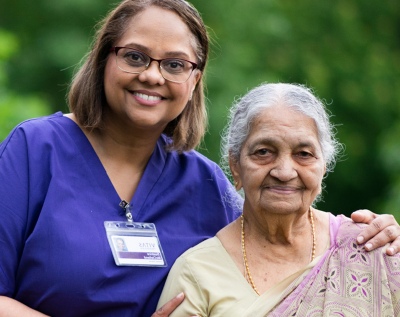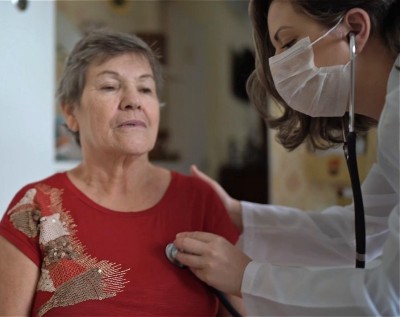Underutilization of Hospice Among Certain Groups Leads to Disparities in End-of-life Care
By Dr. Joseph Shega, Chief Medical Officer, VITAS Healthcare
Hospice provides myriad benefits to patients nearing the end of life: improved quality of life, better symptom and pain control, and greater patient and family satisfaction. However, despite increases year over year in the number of beneficiaries who used the Medicare Hospice Benefit, hospice remains underutilized in some patient populations. Two such populations present an opportunity for improvement: inpatients placed on Comfort Measures Only (CMO) and patients of color. Both groups face unique barriers to accessing hospice care.
The Need for General Inpatient Hospice (GIP) Among Comfort Measures Only (CMO) Patients
Most hospice care (more than 98%) occurs in the home, whether a private residence, assisted living community, or nursing home. However, when a hospice patient’s symptoms can no longer be managed at home, they may move to a General Inpatient Care (GIP) setting for a short period of time to manage acute symptoms and pain. Despite being one of the four levels of hospice care required by Medicare-certified hospice organizations, GIP care remains uncommon. According to National Hospice and Palliative Care Organization (NHPCO) data, in fiscal year 2022, GIP comprised only 0.88% of Medicare days of care.1

This need for an enhanced level of care is particularly evident when examining hospitalized patients on Comfort Measures Only (CMO), or comfort care—a population that may widely benefit from being admitted to GIP care to manage their pain and other symptoms before returning home to receive routine hospice care.
A 2023 retrospective cohort study by Kozhevnikov et al. showed that around 22% of studied patients who transitioned to CMO status during their terminal hospital admission received general inpatient hospice care before death.2 CMO decedents who died without GIP during their terminal hospitalization were more likely to die in an ICU, have a lower Rothman Index (i.e., a higher risk of adverse events, clinical deterioration, and worse outcomes), and spend less time with CMO status.2 Further, without hospice care, families do not receive the 13 months of bereavement support that hospice provides after the patient’s death.
Improving access to GIP hospice care among patients on CMO and awareness among care team members will result in more patients being able to benefit from the specialty symptom management, treatment of psychological and spiritual distress, and bereavement support that hospice can provide.
Underutilization in Minority Groups
Along with the barriers faced by CMO patients, racial disparities play a significant role in the underutilization of both palliative and hospice care, particularly among minority groups.
A 2024 study by Cid et al. found that minority patients were less likely than White patients to have documented end-of-life care during terminal hospitalizations.3 Using palliative care encounters and do-not-resuscitate (DNR) status as metrics for end-of-life care, the study showed that, compared to White patients, Black patients were 17% less likely to have palliative care encounters and 9% less likely to have DNR status.1
Going beyond this study's metrics, racial disparity can also be seen in hospice utilization. The NHPCO found that among Medicare decedents in 2022, hospice use occurred in 51.6% of White Medicare decedent beneficiaries, but among only 38.3% of Hispanic decedents, 38.1% of Asian-American decedents, 37.4% of Black decedents, and 37.1% of North American Native decedents.1
Improving these metrics may begin with goals-of-care conversations. Initiated by clinicians, these conversations help uncover a patient’s wishes, values, and care preferences. From these discussions, we can help inform patients and their families about their options for end-of-life care, including hospice.
It is our duty as clinicians to have these conversations early and often with our seriously ill patients and their families, so they are well-informed of the care choices available as their disease continues to progress. Healthcare professionals should ask open-ended questions to understand what matters most to patients facing serious illness.
For minority groups, approaching these conversations in a culturally sensitive and respectful manner is paramount. This may include considering language preferences, understanding specific cultural or religious beliefs around illness and death, and involving family members in the decision-making process.
An Opportunity for Change and Improvement
Over the years, hospice awareness and utilization have grown, but it remains underutilized among terminally hospitalized patients on CMO and patients of color. These two unique populations present their own challenges and opportunities regarding access to hospice, highlighting the need for effective goals-of-care conversations to increase hospice awareness and accessibility.
By fostering culturally sensitive conversations that increase awareness of the Medicare Hospice Benefit, we ensure that patients and families from all backgrounds have the option to receive the compassionate, equitable end-of-life care they deserve. These efforts will help bridge disparities and improve the quality of care for countless individuals and their families.
1. National Hospice and Palliative Care Organization. NHPCO Facts and Figures. 2024. Available from: https://www.nhpco.org/hospice-facts-figures [Last accessed: September 11, 2024].2. Kozhevnikov D, et al. Factors associated with inpatient hospice utilization among hospitalized decedents with comfort measures only status. Journal of Palliative Medicine. 2023;26(8):1048-1055. doi:10.1089/jpm.2022.0460
3. Cid M, et al. Disparities in end‐of‐life care for minoritized racial and ethnic patients during terminal hospitalizations in New York State. Journal of the American Geriatrics Society. Published online July 10, 2024. doi:10.1111/jgs.19046

